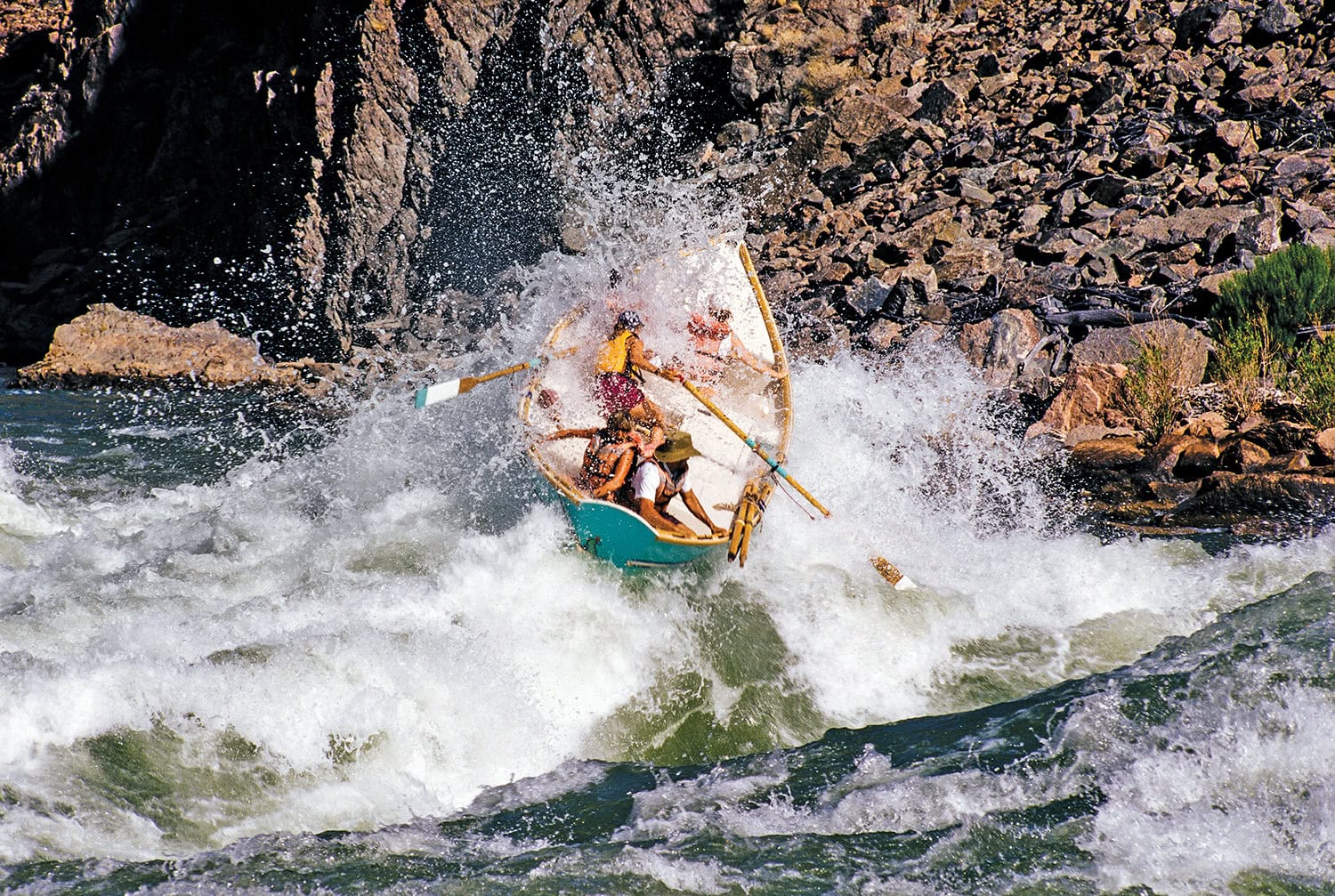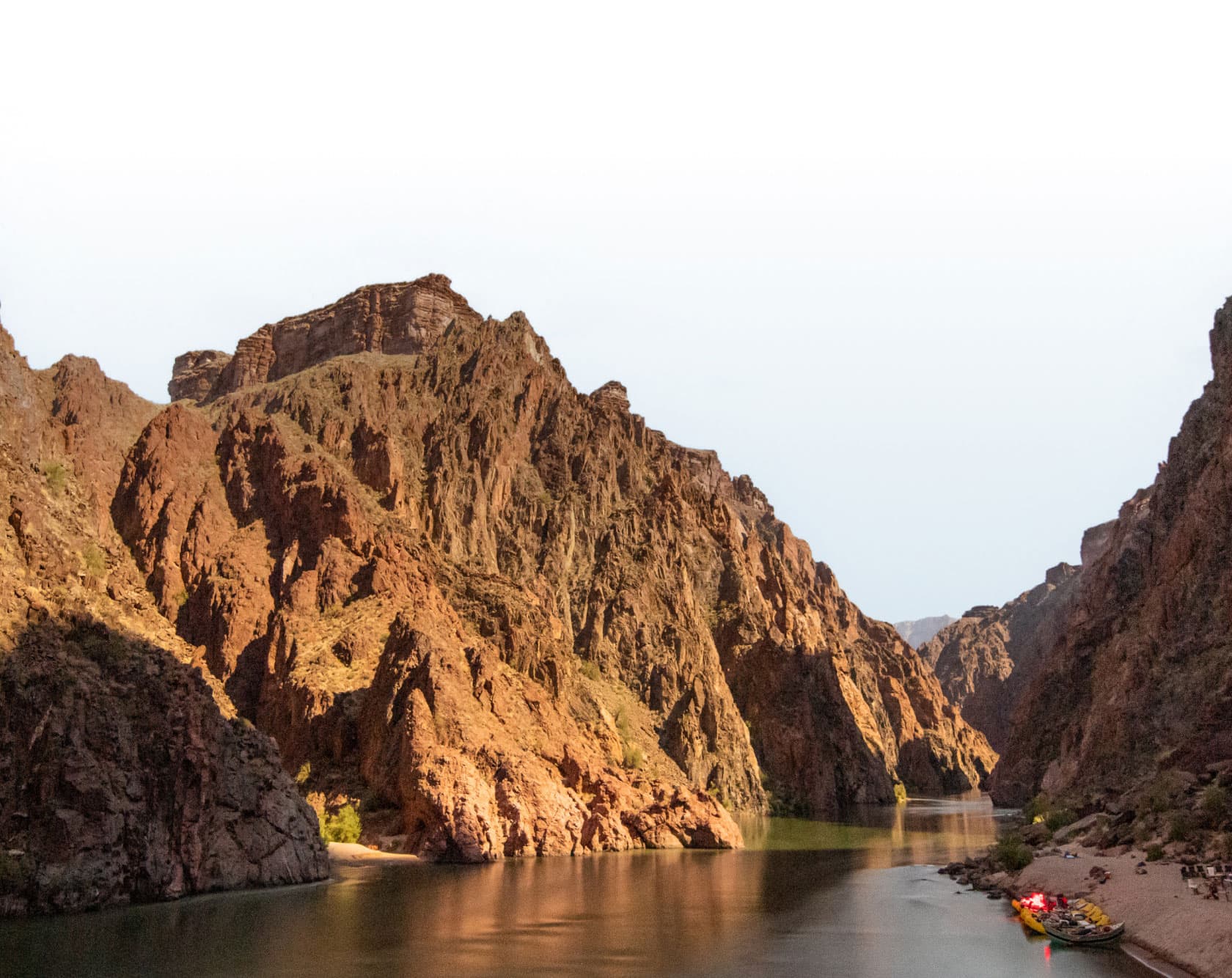The Women Who Rowed


Looking Back With a Few of the Grand Canyon’s Earliest Women Dory Guides
Ellen Tibbetts, Jan Kempster, Elena Kirschner, Denice Napoletano and Mary Williams greeted each other with hugs in front of the OARS Grand Canyon headquarters in Flagstaff. One by one, they walked into the building through the teal door frame and past the photo-plastered walls. A mosaic of photo prints, many of these same women, decorate the space, images of them smiling in the sand, cooking on small stoves on indistinct beaches, and rowing. Rowing the hard-hulled dories that are famous on the Colorado River.
“It’s getting pretty faded,” said Ellen Tibbetts, pointing to a portrait of herself, shot over four decades earlier. “That was the cover of Mariah Magazine.”

These five women represent the first two generations of women to grab hold of the oars on commercial dory trips for Grand Canyon Dories. Many of them worked their way up from being river trip cooks, earning their guide spots with talent, a deep knowledge of the river and a perseverance that wasn’t always required of their male counterparts.
This group came together to visit, share memories from years on the river and to celebrate life-long friendships that were cemented by a shared love for the curved wood (and now fiberglass and foam) dories that gracefully traverse the Colorado River.
“Dories are so special,” said Tibbetts. “To be able to row a dory and get it through the Canyon in one piece is really a huge accomplishment every time you do it. Not just the first time, but every time.”

The First Dory Woman
Tibbetts was the first woman to run full commercial trips in a dory in Grand Canyon, followed soon after by several other women. She started as an assistant cook in 1974, helping to cobble together meals from the frozen meat, cans, cabbages and non-perishables that tumbled around in the hatches of the hard boats.
“We didn’t have coolers, we didn’t have tables, we didn’t have chairs,” she laughed. “We had cabbage. And potatoes, apples, onions and a lot of cans.”
In 1980, while Martin Litton was still the owner of Grand Canyon Dories, Tibbetts got the chance to sit in the coveted guide seat of the hard-hulled boats. It happened fast. Another dory guide couldn’t make a trip and there were a couple passengers added on, management asked Tibbetts to step in.
“It wasn’t like I had to try to get in. It was like you’re here, you’ve trained. It was now or never,” Tibbetts said. “Once you did it, it was like, okay, I can do this…Luckily I didn’t have any trouble on the first trip. That was later.”
“I felt a lot of pressure to not make a mistake because it would’ve been blamed on your size or your gender,” Tibbetts said. “I felt pressure to do everything perfectly.”
In a way, working as a cook had advantages in learning to row in Grand Canyon, Tibbetts said. Cooks often rode with a variety of guides and were able to study technique and the sinuous lines through the rapids. While leading customers on foot around some of the technical whitewater, they watched from shore as guides navigated through rock gardens and dangerous stretches. The cooks did occasionally get the chance to row the dories during trips.
“When they’d let you row their dory, they’d be like, ‘a little to the left,’ just a little backseat driving,” said Denice Napoletano, who started as a cook for Grand Canyon Dories in 1984. “But it was always quiet so the passengers couldn’t hear, really supportive and very helpful.”

‘You Can Never Be Stronger Than the Colorado River’
In the Grand Canyon, the ratio of female to male river guides has always been, and continues to be, imbalanced. Though the early women dory guides who visited the OARS warehouse in August agreed they’d mostly felt supported by their male peers, there were still differing standards and perceptions from guests for men and women guides.
“I felt a lot of pressure to not make a mistake because it would’ve been blamed on your size or your gender,” Tibbetts said. “I felt pressure to do everything perfectly.”
One of the misconceptions that’s still common in the Canyon is guides have to be big and strong to row through the Colorado River’s dynamic whitewater. Rowing a dory is more about technique and an understanding of the river’s powerful currents than sheer muscle, according to many long-term guides.
“One thing [Ellen] told me early on is you can never be stronger than the Colorado River, even men can’t be,” said Jan Kempster, another visiting guide. “What you have to learn is how to read the water.”
Still, it can be a misunderstanding that hurts a little.
“I could have golden runs forever and it comes down to Lava Falls and [some people] will choose the biggest strongest guide,” said Cindell Dale, who started as a cook in the 1980s and continues to row dories for OARS.
“And it’s because they have their own personal fears. I can only do so much for that with my performance. It hurts, but you have to live with that if you want to keep rowing. You can’t let it get to you—even though it gets to you.”

Pushing the Next Generation
Tibbetts didn’t think of being the first woman to row a dory as a revolution or blazing a trail at the time. She remembered a lot of support from fellow guides, both male and female. There were a lot of women rowing rafts at the time, and there was the famous female river runner Georgie White, who led hundreds of rowdy trips in Grand Canyon from the motor well of her 35-foot G-rig. Tibbetts also recalled how much work she’d done, memorizing the rapids and features of the 280-mile stretch of Colorado River while riding with other, sometimes less experienced guides.
“For myself, it was never a goal for me. I just wanted to be in the canyon,” Tibbetts said. “I liked to row and one thing led to another and then there was an opportunity.”
Her calm and fluid way of rowing, inspired a whole generation of younger guides. On their visit to the OARS Grand Canyon warehouse, Elena Kirschner remembered one particular run with Tibbetts through Crystal Rapid, Tibbetts’ incredible intuition and a special connection the women shared while rowing together.
“At the exact instant I thought she should pull, she pulled.” Kirschner said. “It was like our minds were one. It was incredible. It was just so cool to feel that. A lot of us rowed through Crystal and had that. It was very bonding to be together in that experience.”
The women gravitated towards dories for a variety of reasons: The artfulness of their design, the responsive touch of the oars and just how fun they were to row through whitewater. When a guide takes a boat down a river, they form a relationship. With dories, these connections can last years or decades.
“We tied the boats together every night so everyone was connected,” said Mary Williams, who worked as a dory guide from the early 1990s into the late 2000s.
“There was just something special and magical about having this beautiful little wooden home for a trip.”
For other women guides, the dories represented the top of the industry. Being a dory guide in Grand Canyon meant, and still means, you are an elite rower.
“I see the dories as a pinnacle as far as rowing crafts through the Grand Canyon,” said Kempster. “I feel proud that I went into this profession and reached somewhat of a pinnacle.”
Many of the women guides spoke of the strong bonds between the crew they worked with during their trips in Grand Canyon. The kinship with their fellow guides and staff kept them returning trip after trip. When asked why she loved working as a guide, Tibbetts was quick to answer, “It was amazing to be with the crew and the people we worked with—It was an amazing family.”

Passing the Oars
After training for years, young guides are often handed the oars of a special boat that they’ve learned to row from a more senior guide who may have spent years or decades in the guide seat. For Cindell Dale, she rows the Ticaboo and was handed the oars by Jan Kempster. She looks forward to passing the classic dory on to a young guide. Now, as a senior guide, she feels a responsibility to the younger rowers.
“I’m about making sure those young guides, male or female, have the right tools to carry on the legacy of what Martin and George [Wendt] started down here in Grand Canyon,” she said. “That’s our job as senior guides. If they’ll listen, we can teach them things.”
The current generation of female dory guides has impressed their predecessors.
“They’re so brave and so competent,” said Kirschner. “And they’re just shining out there.”
And for the young women who have yet to take up the oars, but are considering it, the dory guides have some choice advice.
“Somebody told me, ‘You should do it because when you’re 80 years old, you’re going to wish you did,’” Tibbetts said.
New Film: About Damn Time
Get a first look at About Damn Time, a short film presented by OARS about the dory women of Grand Canyon, which will be on tour with the Wild & Scenic Film Festival in 2025. Watch the trailer and be on the lookout for a screening near you.
Related Posts
Sign up for Our Newsletter





